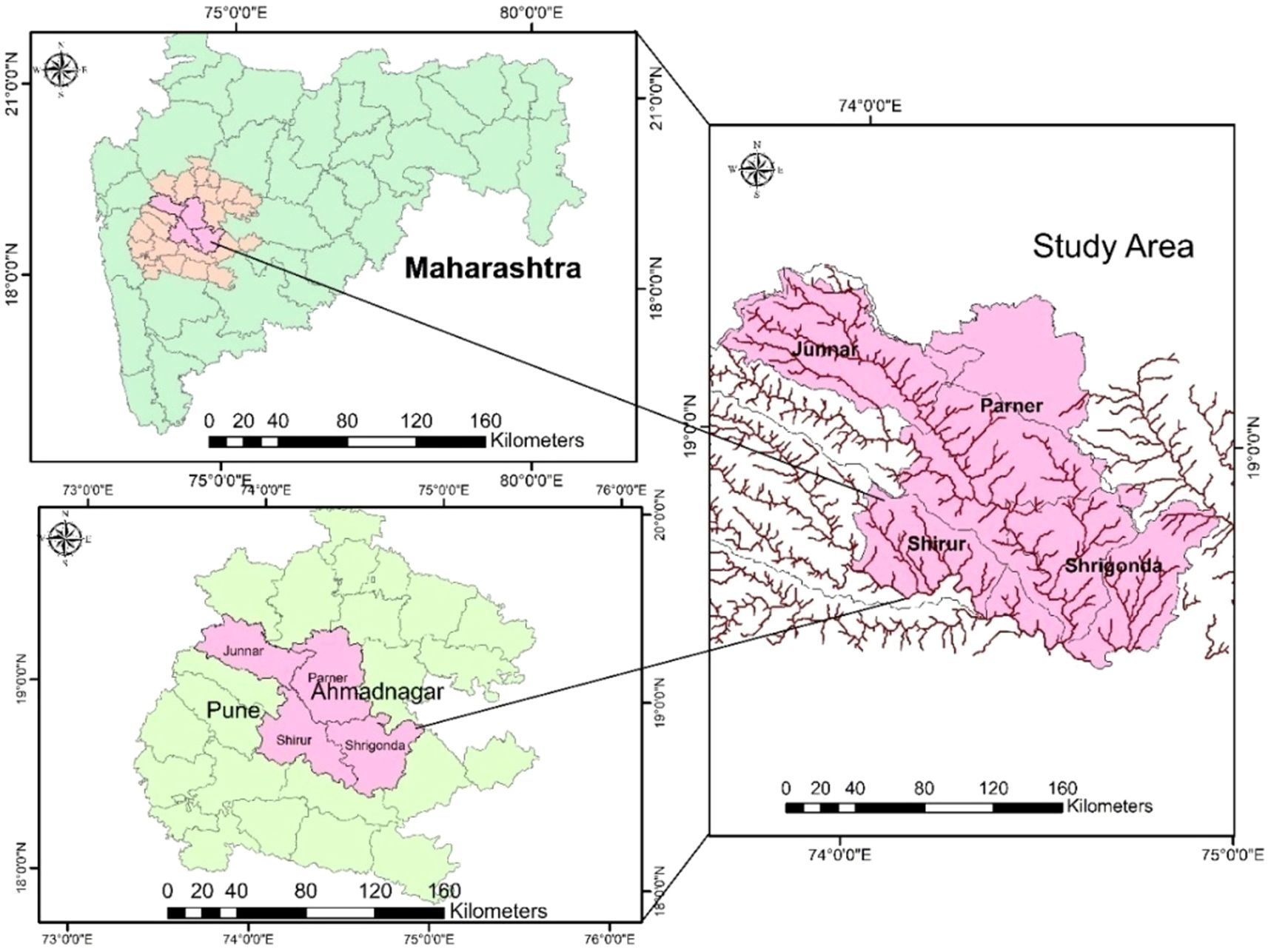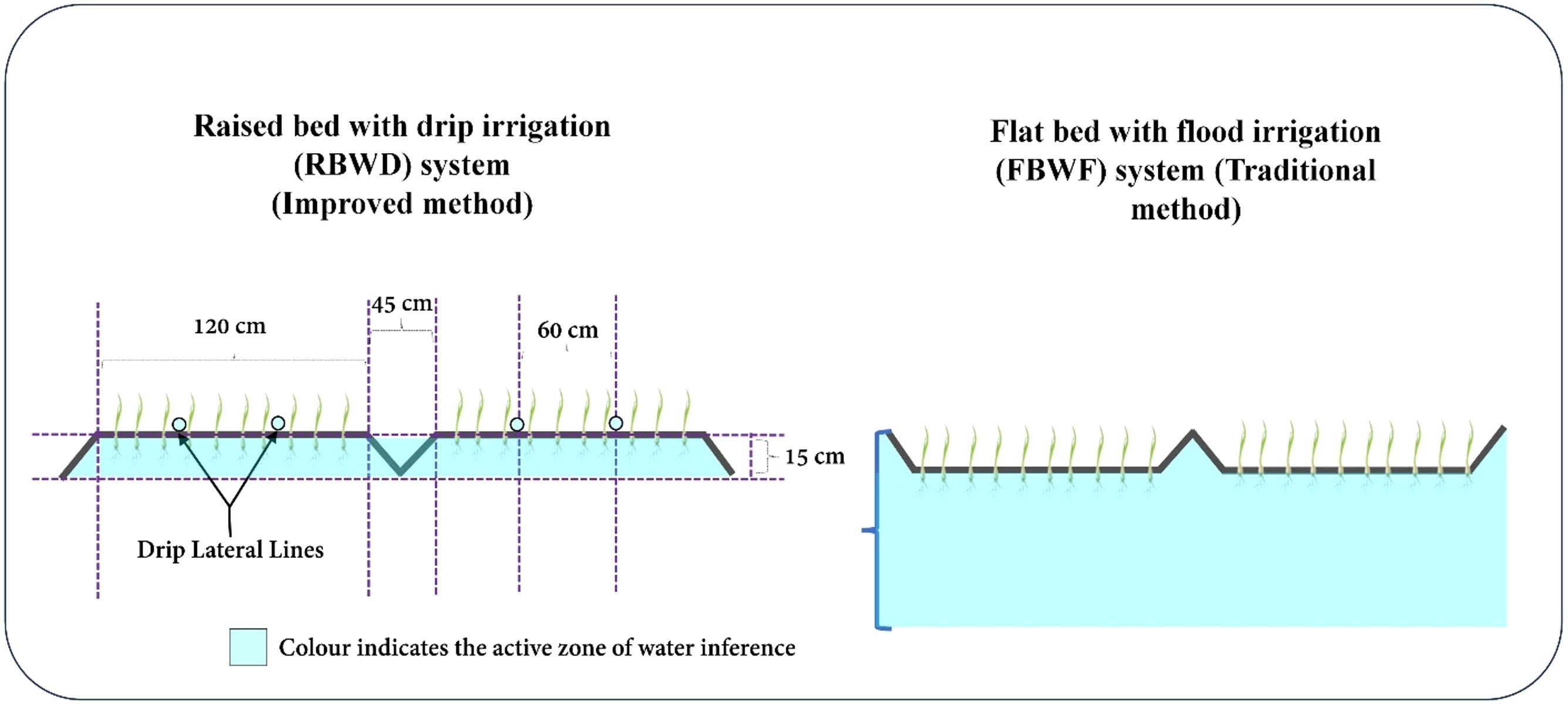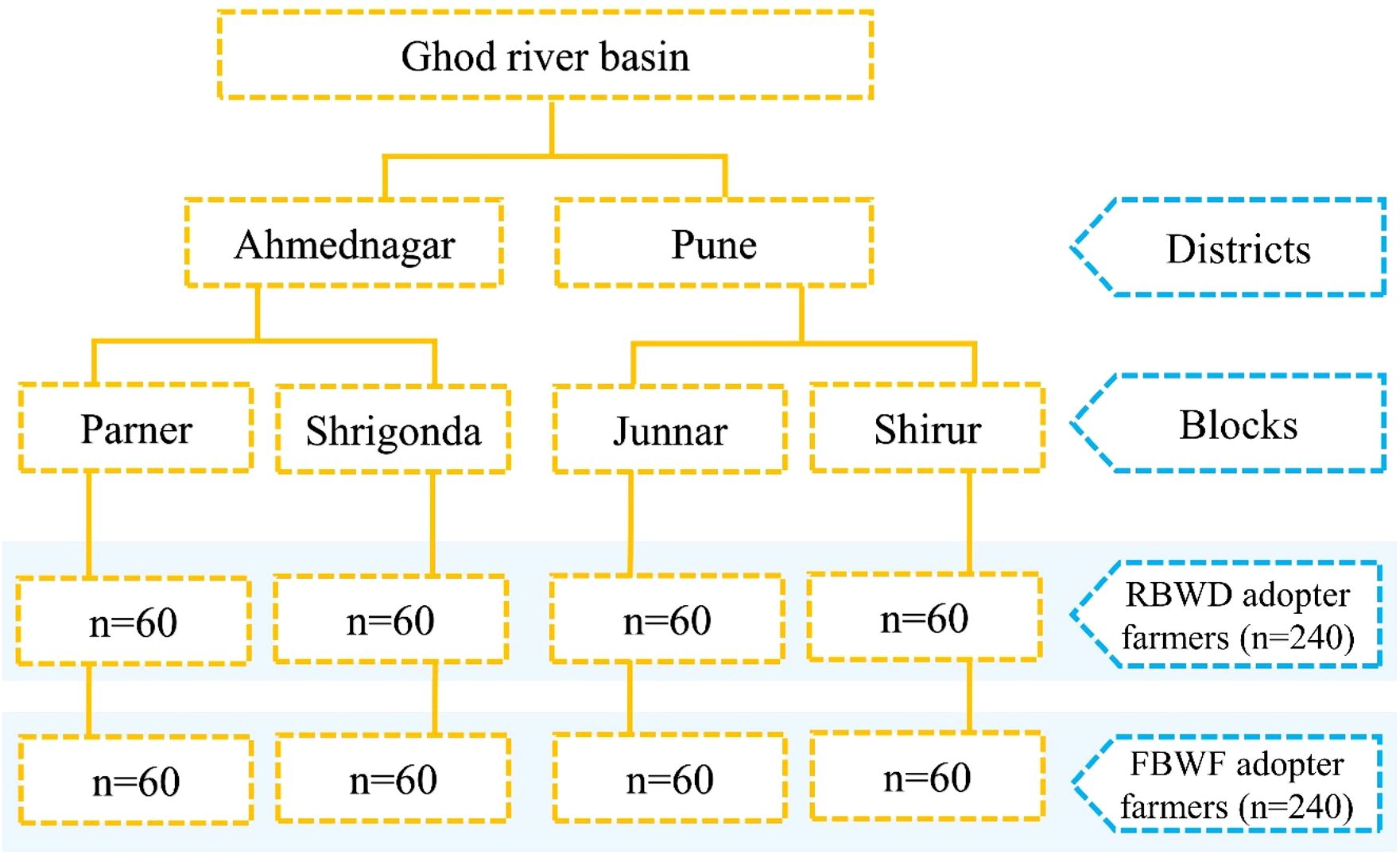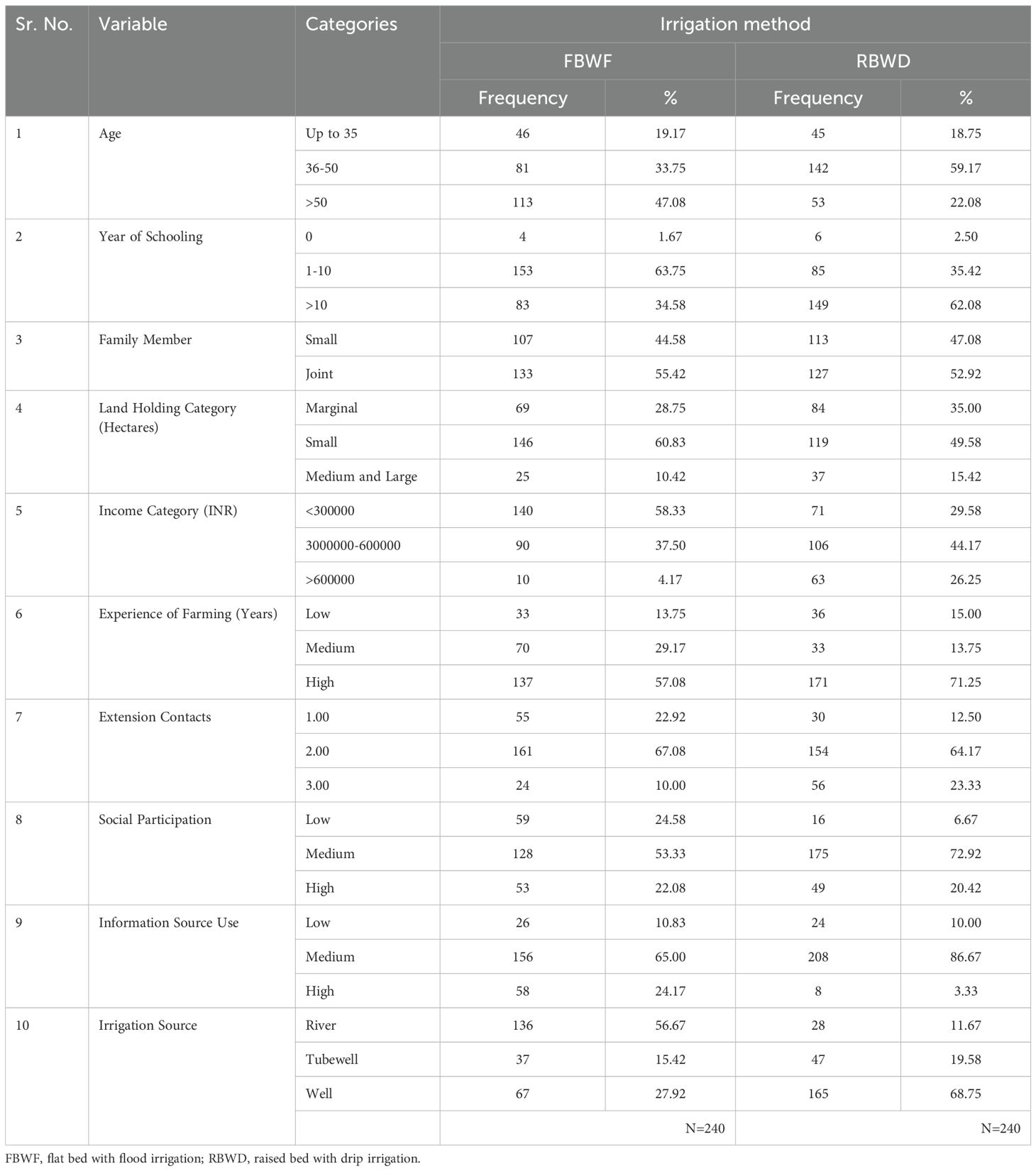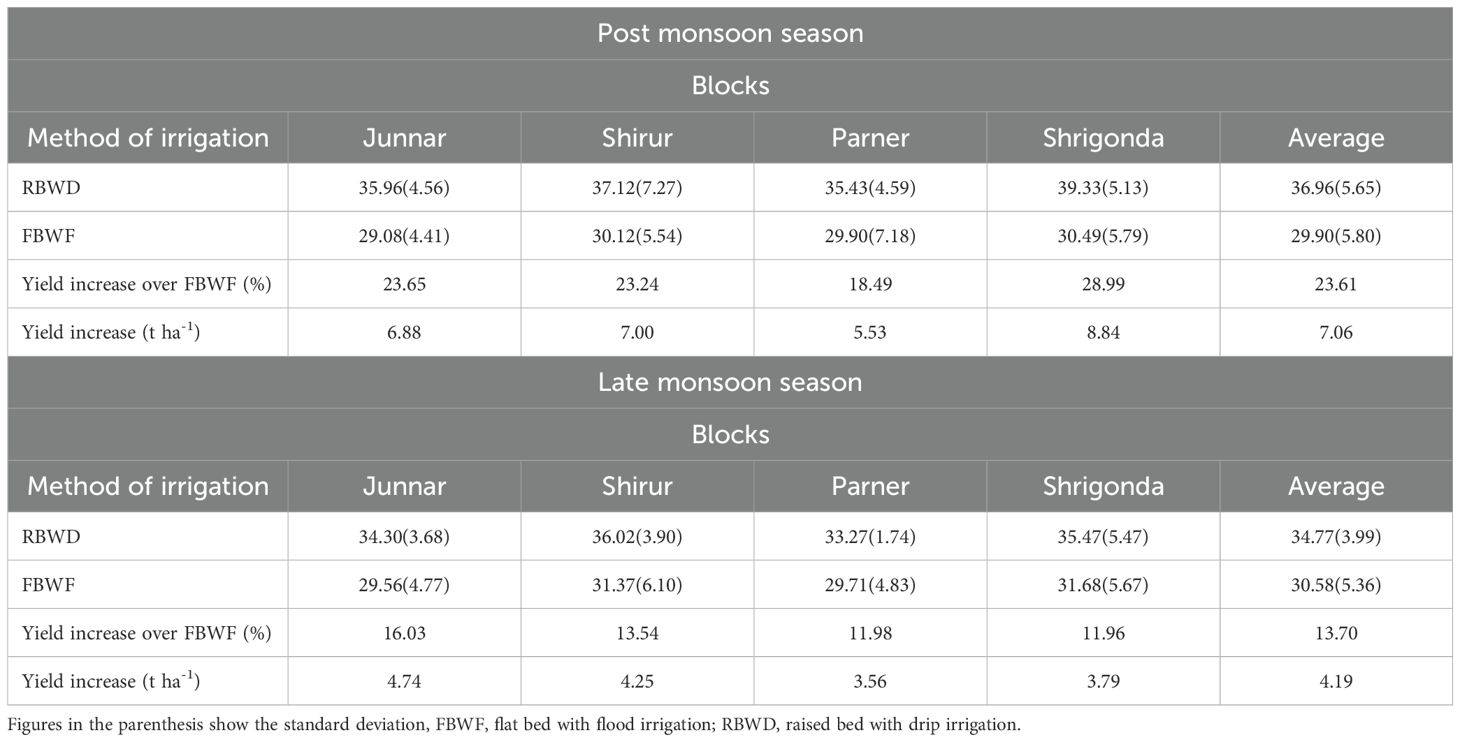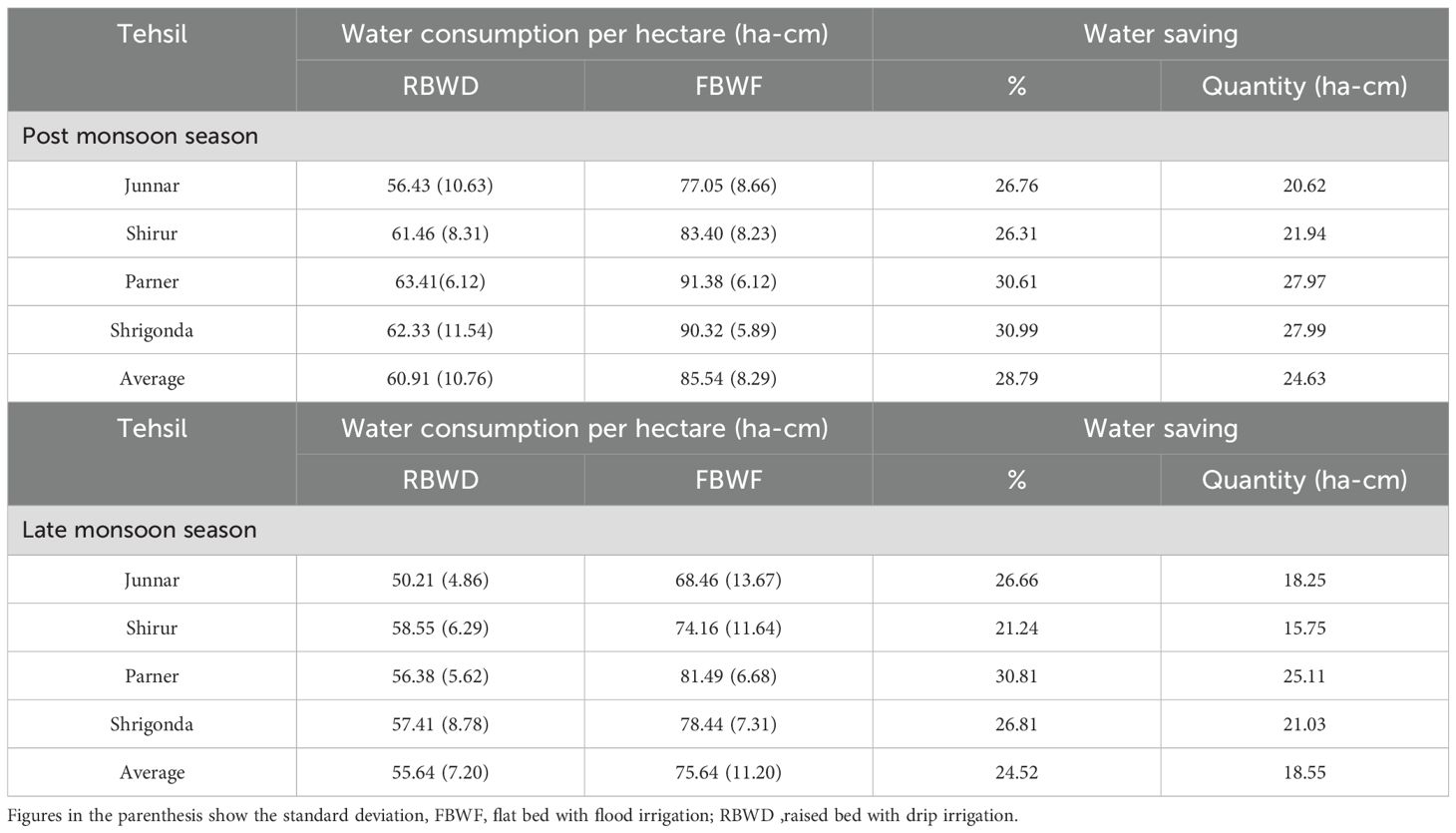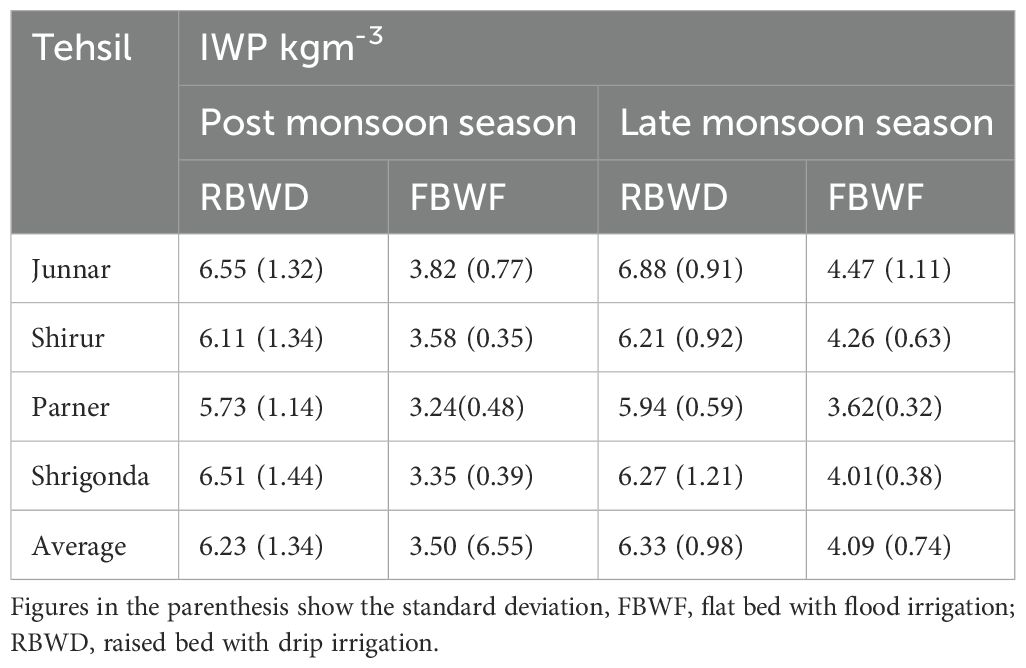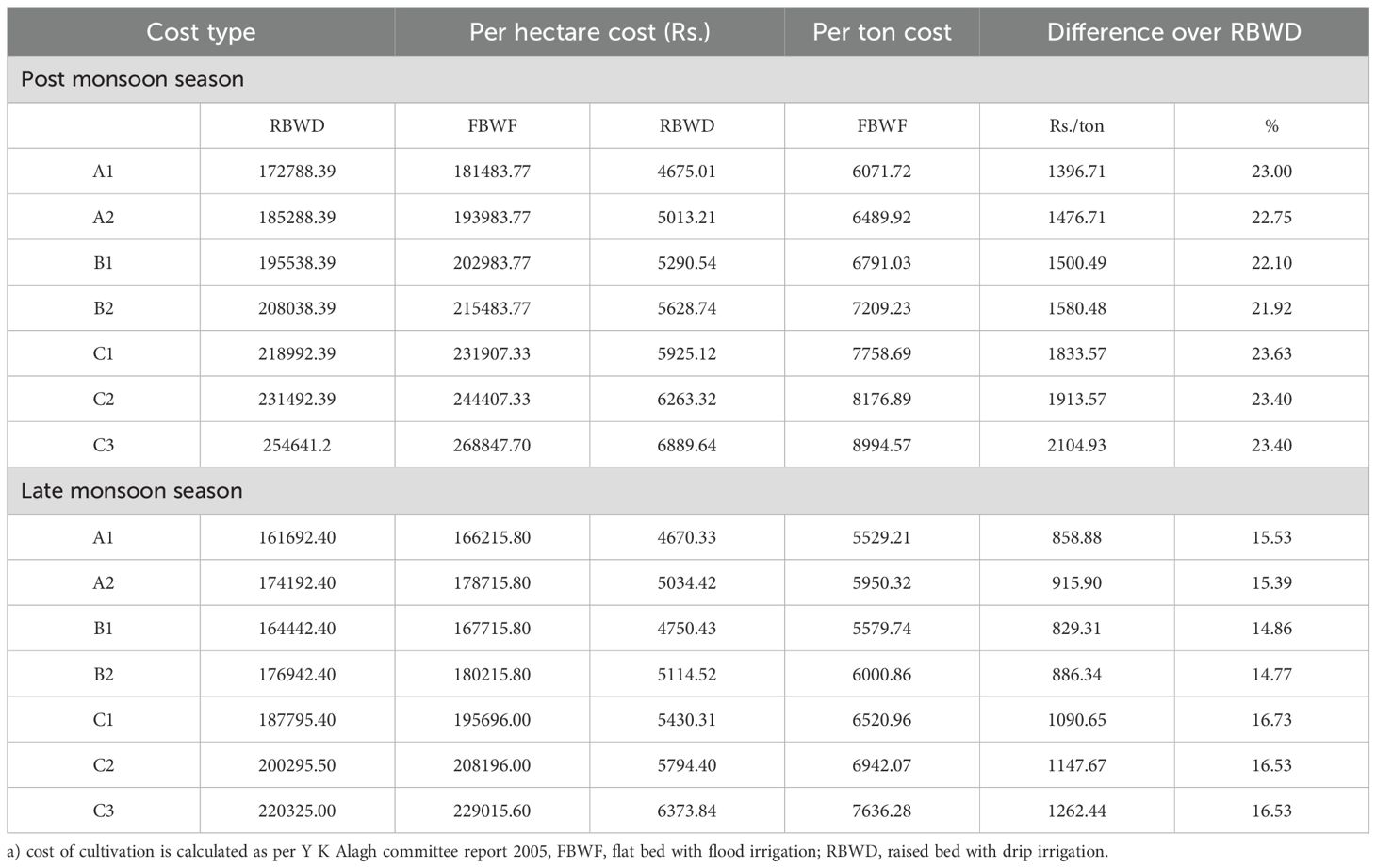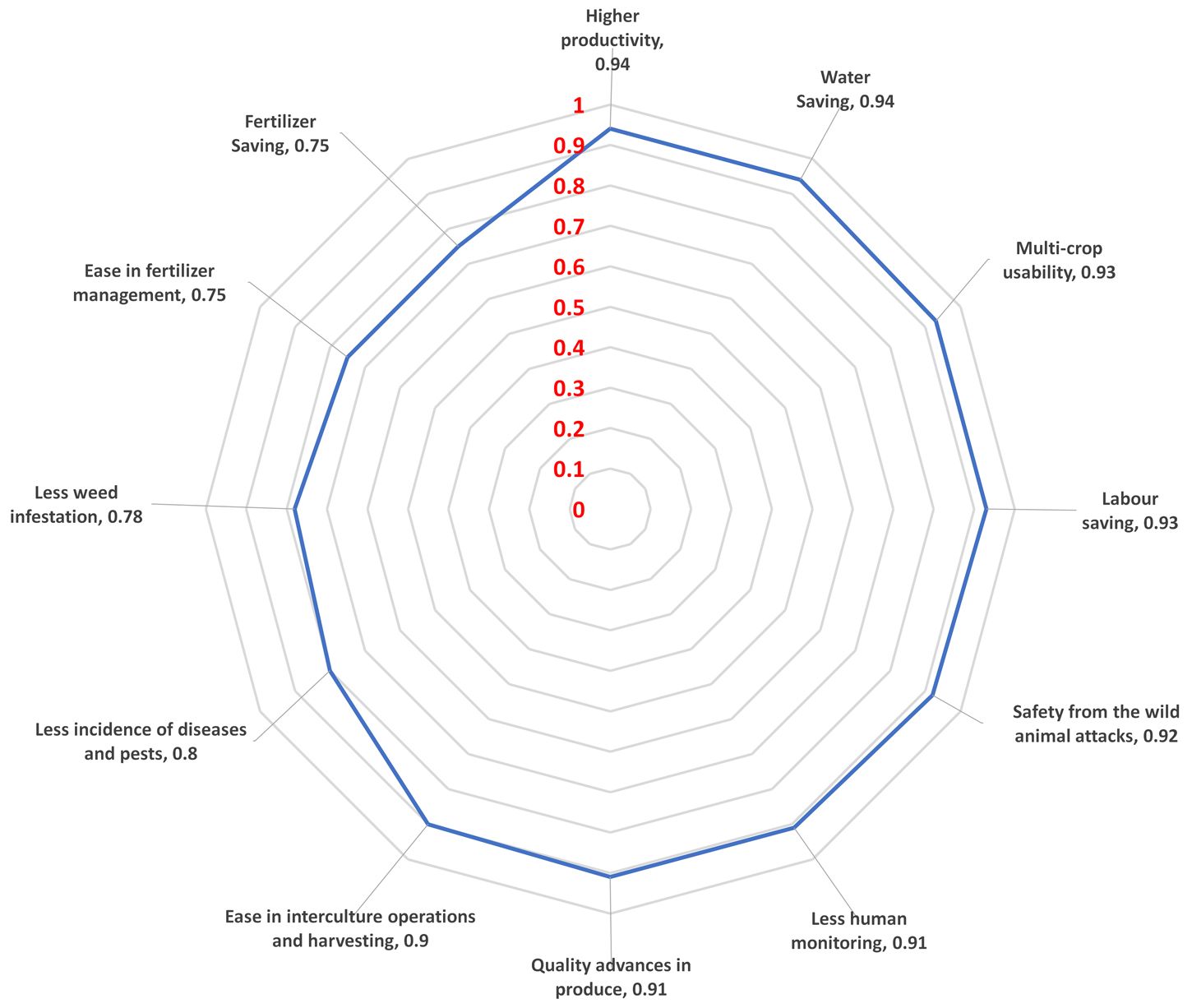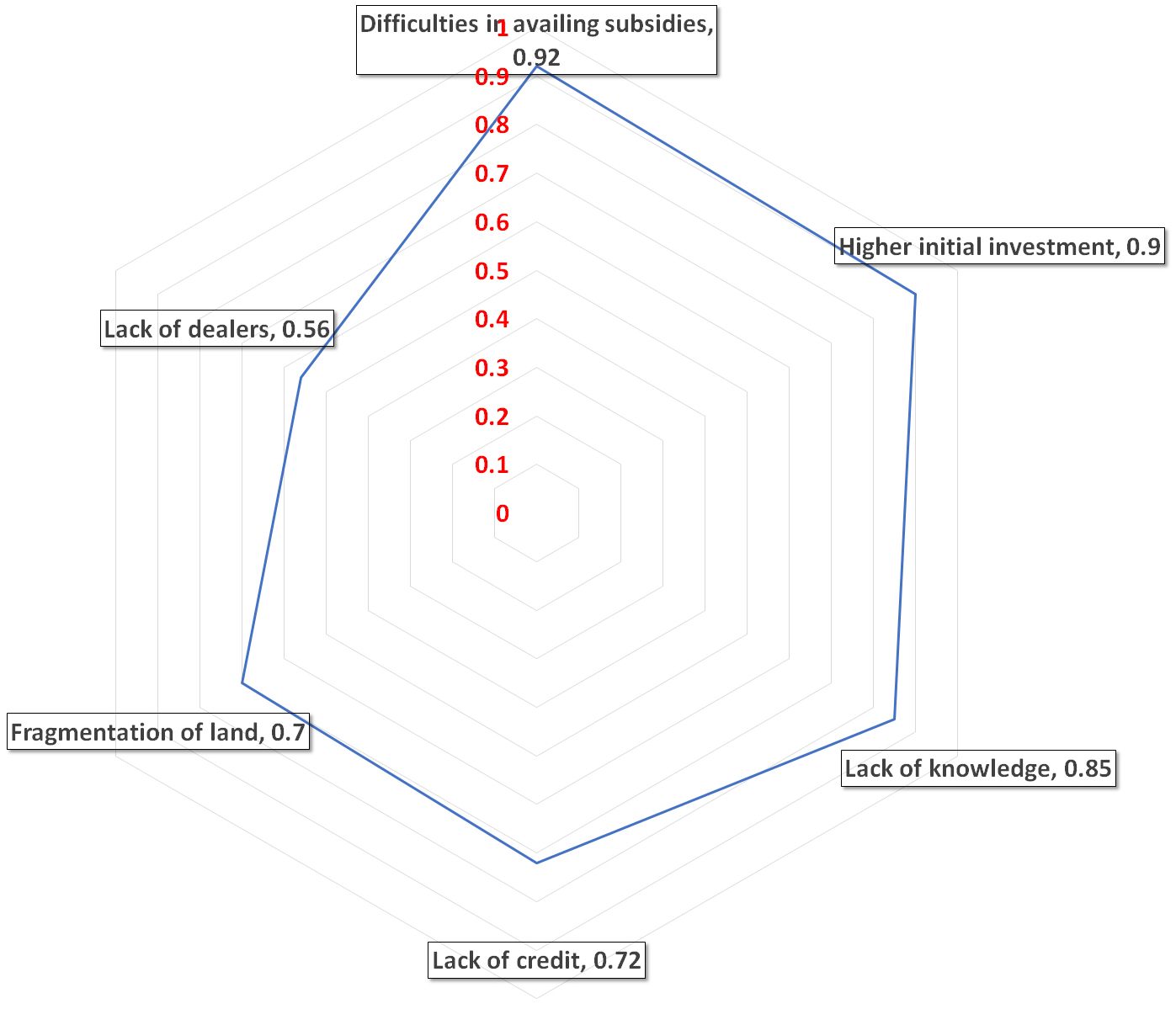- 1ICAR-Directorate of Onion and Garlic Research, Pune, Maharashtra, India
- 2Navsari Agriculture University, Navsari, Gujrat, India
The onion cultivation sector in India is grappling with severe challenges, including acute water scarcity, labor shortages, and a sluggish adoption of sustainable agronomic practices. These issues collectively exacerbate the sector’s vulnerability to climate change and production uncertainties. This study critically evaluated the efficacy of an advanced irrigation management practice raised bed with drip irrigation (RBWD) and examined the socio-economic determinants influencing its adoption. Conducted in Maharashtra’s Ghod River basin during the 2022–2023 cropping seasons, the research encompassed 480 farmers equally divided between RBWD adopters and traditional flat bed with flood irrigation (FBWF) practitioners. The findings revealed that RBWD adoption led to significant water savings, averaging 24.52% during the late monsoon and 28.79% in the post-monsoon season while doubling water productivity compared to FBWF systems. Moreover, the implementation of RBWD resulted in a substantial increase in onion bulb yield, ranging from 13.70% to 23.61%, and enhanced bulb quality, particularly in the proportion of marketable bulbs. Family income, land holding, extension contacts and the information source use were the key determinants behind the adoption of the RBWD method. However, significant obstacles such as the high initial investment required for drip irrigation systems and the technical expertise needed for their operation continue to hinder wider adoption. These findings underscore a pressing need to address these barriers through policy interventions and targeted extension services.
1 Introduction
Onion (Allium cepa L.) holds a pivotal position in global vegetable production. India, as the largest producer, contributes approximately 32.53% to the global onion production (FAOSTAT 2024). Despite India’s prominent role in onion production, the sector faces several challenges, including climatic variability, water scarcity, and pest infestations, which threaten the consistency of production. Maharashtra is the cornerstone of India’s onion production, contributing around 45% of national output and about 10% of the global production. It’s diverse agro-climatic conditions allow onion cultivation across three main seasons-Kharif, late Kharif, and Rabi. However, it is particularly vulnerable to water scarcity and climatic unpredictability. In recent years, the frequency of extreme weather events, including unseasonal rains and droughts, has escalated, leading to adverse conditions like waterlogging, bulb rot, and higher disease incidence (Gedam et al., 2021; Khandagale et al., 2022; Sansan et al., 2024). Water availability during critical growth stages, particularly during bulb initiation and development, is a major concern, as insufficient water leads to smaller bulbs, lower yields, and diminished quality. Declining groundwater tables and growing urban–industrial competition for water further exacerbate the challenge (Li et al., 2016; Abou Fayssal et al., 2024; Singh et al., 2024).
The Ghod River basin, situated in Agro-Ecological Region-6 of Maharashtra, is critical to regional agricultural sector (Igbadun et al., 2012). Spanning around 71,500 hectares across the Pune and Ahmednagar districts of the state, agricultural productivity in the basin largely depends on monsoon-driven water flows, which significantly decrease during dry periods (Binoy et al., 2023). Increasing competition for water resources from industrial and domestic sectors, combined with the intensification of water-demanding crops like sugarcane, has created a pressing need for more efficient water management practices (Putra et al., 2020; Sharma et al., 2025; Udmale et al., 2014; Garg et al., 2012). Given these constraints, the adoption of water-efficient technologies, especially for a commercial crop like onion is vital for ensuring the sustainability of agricultural practices in the region.
Drip irrigation emerged as a viable solution to water scarcity by delivering water directly to the plant root zone, significantly reducing losses through evaporation and deep percolation compared to traditional flood irrigation methods (Patel et al., 2023). Studies have shown that drip irrigation can reduce water usage by up to 40%, while simultaneously improving water use efficiency and crop productivity (Kebebe, 2019). In addition to conserving water, drip irrigation helps maintain optimal soil moisture levels, mitigates the risk of waterlogging, and facilitates efficient fertigation, enhancing nutrient availability and crop yields (Udmale et al., 2014; Yang et al., 2023a).
The integration of drip irrigation with raised bed cultivation help to improve drainage, prevents waterlogging and soil structure offer several benefits, including enhanced soil aeration, uniform moisture distribution, improved root development, and reduced incidence of soil-borne diseases () (Gadge et al., 2022; Ramalan et al., 2010; Chand et al., 2020; Kebebe, 2019). Recent studies have demonstrated that the RBWD system can achieve up to 24.5% water savings and increase bulb yields by 23.61% compared to conventional flood irrigation methods (Kebebe, 2019). Onion crop often demands high irrigation frequency ascribed to its shallow root system (15–25 cm below soil surface). Hence, adoption of RBWD could save significant amount of water otherwise lost by traditional flood irrigation method. However, the quantum of the impact of RBWD technology is highly dependent upon the technical efficiency of adopting/non-adopting onion growers, as depicted in the recent study by Kebebe (2019).
Despite it’s potential, adoption of drip irrigation in Maharashtra remains low, with drip irrigation covering only 6.13% (9.38 lakh hectares) (FAOSTAT 2024; Hla and Thomas, 2003) of the total net cultivable land (152.91 lakh hectares). Previous studies documented the several socio-economic and institutional factors influencing adoption of drip irrigation such as access to information, financial resources, landholding size, extension services (Udmale et al., 2014); high initial costs, limited access to credit (Serote et al., 2023; Gadge et al., 2022); peer influence and community norms, training (Chand et al., 2020); fragmentation of landholdings and irrigation sources (Garg et al., 2012). While previous studies have documented either the technical benefits of drip or the socioeconomic constraints affecting its adoption, this study addresses that gap by evaluating the agronomic and economic impacts of Raised Bed with Drip Irrigation (RBWD) technology adoption in onion farming within the Ghod River basin. It compares RBWD with traditional irrigation practices in terms of yield, water savings, and profitability, while also analyzing farmer-level factors influencing adoption. The findings are expected to inform targeted interventions that can enhance RBWD adoption, strengthen water-use efficiency, and promote sustainable onion production in water-scarce regions.
2 Materials and methods
2.1 Location of study
The Ghod River is a tributary of the Bhima River, covering approximately 71,500 hectares in the Ambegaon, Junnar, Shirur, Parner, and Shrigonda blocks of Pune and Ahmednagar districts in Maharashtra (Figure 1). The catchment area of this river receives an annual rainfall ranging between 900 and 1200 mm, while the lower basin, where the surveying was done, receives the annual rainfall of approximately 600–800 mm. Farmers in this area rely on water from the Ghod River and groundwater for agriculture. The selected area is one of the prominent contributors to onion production in Maharashtra (Kebebe, 2019).
2.2 Cropping pattern of area
The cropping pattern within the Ghod River basin area exhibits rich diversity due to variations in geography, soil type, rainfall, and the availability of irrigation sources. During the monsoon season, a variety of crops, including soybean, bajra, onion, groundnut, and mung bean, are commonly cultivated. Additionally, irrigated crops such as vegetables, flowers, and sugarcane thrive in this region. In areas where irrigation projects are established, sugarcane, onion, and various fruit crops dominate during the post-monsoon season. However, in instances where alternate irrigation sources are lacking, crops like sorghum and gram are grown, and their success is closely tied to rainfall and residual soil moisture levels. This cropping pattern is intricately linked with water availability, prevailing market trends, and proximity to markets (ITC, 2020). Furthermore, the well-developed dairy infrastructure in the area necessitates the cultivation of fodder crops tailored to the specific needs of the livestock industry. The Ghod River plays a crucial role in sustaining agriculture and livelihoods in the region. Its diverse cropping practices reflect the intricate balance between natural resources, market dynamics, and the needs of local communities.
2.3 Capacity building and demonstrations
To enhance the water-use efficiency and productivity in onion farming, a range of extension initiatives i.e. training programs, on-field demonstrations (OFDs), and farmer field schools were implemented. A total of 240 farmers (60 nos. from each block) undertook training to enhance their capacity to utilize improved water management technologies. The trained farmers’ fields were selected for conducting demonstrations to evaluate the impact of these improved technologies on onion production. To ensure ongoing support, socially integrated messaging applications were used to form groups, facilitating regular advisory services for participating farmers in the demonstration plots. Additionally, field visits were organized to monitor the progress of the farmers’ plots. Similarly, farmers had exposure visits to the ICAR-Directorate of Onion and Garlic Research in Pune, where they learned from established practices and research. The adoption of these strategies aimed at optimizing onion cultivation while conserving water resources and promoting sustainable agricultural practices.
2.4 The raised bed with drip irrigation system
The raised bed with drip irrigation system has gained prominence in various crop production systems due to its significant advantages in water and soil management (Gadge et al., 2022; Piri and Naserin, 2020; Gorantiwar et al., 1991). This system offers improved drainage for excess rainfall and creates favorable soil conditions. When combined with drip irrigation, one of the most efficient water management methods, studies have shown that it enhances both yield and onion quality (Gethe et al., 2006; Saudy and El–Metwally, 2019). Specifically, for onion cultivation, the recommended raised bed with drip irrigation system (RBWD) (Figure 2) consists of a broad bed furrow (BBF) with dimensions of 15 cm height and 120 cm top width, along with a 45 cm furrow. Each BBF should be equipped with two drip laterals, approximately 16 mm in size, spaced at 60 cm intervals and featuring inbuilt emitters. The distance between these emitters should range from 30 to 50 cm, with a discharge flow rate of 4 liters per hour (Thangasamy and Singh, 2022). This system optimizes water use, promotes efficient onion growth, and contributes to sustainable agriculture practices.
2.5 Data collection and statistical analysis
A team of trained enumerators conducted face-to-face interviews with selected farmers using a pre-tested structured interview schedule. During these interviews, the enumerators explained the study’s purpose, obtained informed consent, and assured respondents of the confidentiality of their information. Data collection occurred during the late monsoon and post-monsoon seasons of 2022–23 to capture seasonal variations (Figure 3). The study employed a purposive sampling approach. Four blocks were purposively selected as demonstrations had been carried out there, and seven villages from each block were further chosen purposively, resulting in 28 villages. In total, 480 farmers from four blocks participated in the study. The study focused on 240 demonstrated farmers who had adopted raised beds with drip irrigation from the total of 28 villages. An equal number of farmers served as controls and were selected from the same blocks. Uniformity among the farmers selected as treated and control was assured for their soil type, soil and irrigation conditions etc. to compare them. Further, any field level differences found were eliminated by using more averaging greater population sample and close monitoring for the good agriculture practices. For comparing irrigation conditions, all the farmers in the survey were closely monitored and the actual measurement of each drip and flood irrigated farm has been carried out at each farm level. Among these, 160 farmers were purposively selected for the late monsoon (October to November transplanting locally known as late Kharif planting) season, while 320 farmers were chosen for the post-monsoon season (December to January transplanting locally known as Rabi planting). The interview schedule covered various socioeconomic and demographic aspects of the participant farmers. To assess the field-level impact, the farmers’ onion production, yield and quality-related aspects were monitored over time. Additionally, water use assessment involved monitoring irrigation operations and interviewing related rationales. The study’s general outcomes are represented using simple descriptive statistics, focusing on parameters such as onion productivity, produce quality, and water use. Furthermore, the association between socioeconomic factors and the adoption decision of raised beds with drip irrigation was calculated using a binary regression model.
2.6 Association of socioeconomic variables with the adoption of RBWD
The logistic regression model was used to analyze the relationship between socio-economic variables and a binary outcome. Specifically, the outcome variable takes the value of ‘0’ when farmers practice flat bed with flood irrigation (FBWF) method, and ‘1’ when they use the improved method, raised bed with drip irrigation (RBWD). A comprehensive review of previous studies by Bravo-Ureta and Evenson (1994); Iráizoz et al. (2003) and Wilson et al., 2001) suggest that several factors influence farmers’ decisions regarding technology adoption. After conducting a contextual analysis of the study area, socioeconomic factors assumed to impact technical efficiency were selected. These factors, along with their expected signs, are described in Table 1.
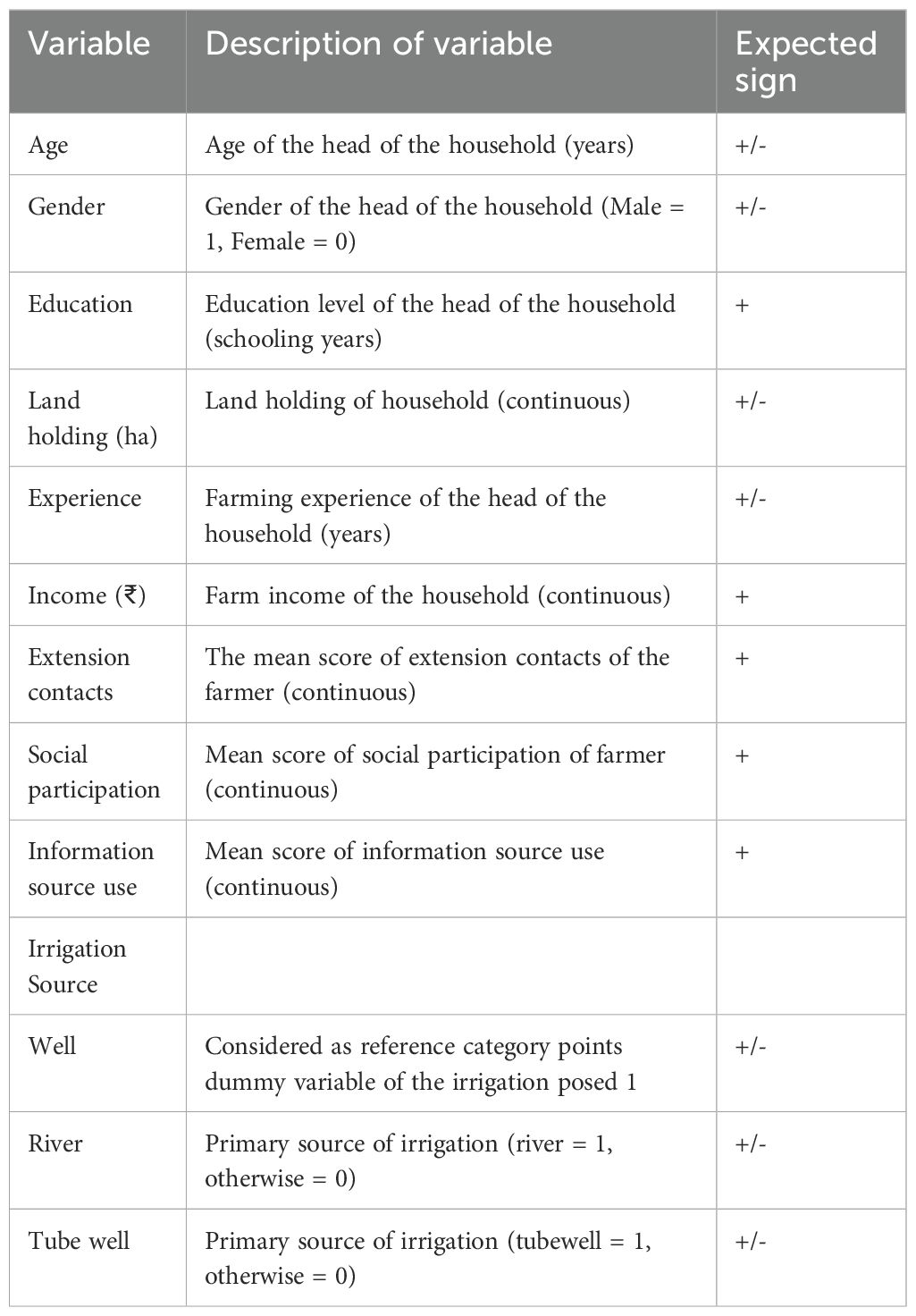
Table 1. Expected influence of socioeconomic variables on the adoption of raised bed with drip irrigation (RBWD).
2.7 Model specification
To predict the dependent variable i.e. the adoption decision of the RBWD system, the Logit model can be described as.
Where is the probability that a farmer adopted RBWD.
Where is the probability that a farmer did not adopt RBWD.
Taking logarithms on both sides it becomes-
Where,
α is the intercept,
β is the vector of the response coefficient.
e is the vector of random disturbance.
and
Xn is the set of explanatory variables.
So, the equation to be estimated can be written as.
Adoption=β0+β1 age+β2 Gender+β3 Education+β4 Land holding+β5 Experience+β6 Income++β7 Extension contact+β8 Socialpart+β9 Information source+β10 Irrigation river+β11 Irrigation tubewell.
Where,
Adoption is a binary variable for adoption and non-adoption of RBWD irrigation technology by onion growers,
are coefficients associated with each explanatory variable and is the error term.
The maximum likelihood estimation method was employed to obtain the parameter estimates. The model was assessed for goodness-of-fit using appropriate diagnostic tests (Hosmer-Lemeaqshow test, ROC curve). Additionally, multicollinearity among independent variables was also checked.
2.8 Water usage and irrigation water productivity
Irrigation water productivity in kg.m3 (IWP) serves as a valuable metric for assessing water use efficiency in agricultural systems. Unlike climatic factors, which have a lesser impact on IWP, agronomic practice factors significantly influence it (Lv et al., 2019). For the flat bed with flood irrigation (FBWF) method, the irrigation water applied during the entire onion production season is calculated based on the average number of irrigations, hours per irrigation, and the water discharge efficiency of the pump used by individual farmers. Whereas, for raised bed with drip irrigation (RBWD) adoption, the per-hour water discharge from a dripper and the average drip system use time throughout the season are considered (Guo et al., 2023; Yang et al., 2023b). The resulting water consumption, in terms of irrigation applied to the field, is then used to calculate irrigation water productivity as.
2.9 The economics of onion production
To compare the economics of RBWD and FBWF systems, detailed quantitative data on input quantities, prices, and production cost variables were systematically collected through a semi-structured survey, rigorously monitored by field representatives to ensure accuracy. The economic metrics, including the cost of cultivation and the Benefit-Cost ratio, were calculated in accordance with the Alagh Committee Report (https://cacp.da.gov.in/), one of the standard methodologies employed by the Commission for Agricultural Costs and Prices (CACP) for estimating crop production costs in India. Comprehensive details on the cost of cultivation are provided in Supplementary File 1. The cost analysis was further disaggregated across multiple levels of costs such as—A1, A2, B1, B2, C1, and C2—encompassing key variables such as family labor and imputed rental values of land. To refine the comparison, per-hectare costs were converted to per-ton production costs, enabling a precise evaluation of the differential economic outcomes between the two irrigation systems.
2.10 The drivers of RBWD adoption and the constraints faced by adopters
In the pilot survey, adopters of Raised Bed with Drip Irrigation (RBWD) were examined to identify the key positive factors influencing their decision to adopt the technology. Additionally, challenges faced post-adoption were investigated to understand the dynamics following implementation. The major factors identified in the pilot survey were further evaluated in the main survey using a Likert scale ranging from 1 to 5, where 1 indicated ‘not relevant’ and 5 indicated ‘very relevant’. The collected scores were then normalized into a unity index by dividing the observed score for each factor by the maximum attainable score.
3 Results and discussion
3.1 Socio-personal profile of respondents
The socioeconomic profile of the farmer respondents revealed distinct characteristics between adopters of RBWD technology and non-adopters, particularly those employing the traditional FBWF method. Among the adopters, the middle age group constituted the largest portion of adopters, accounting for 59.2% followed by the older age group at 22.1% (Table 2). In contrast, farmers practicing the traditional irrigation method were predominantly above the age of fifty (47.08%). Adopters tend to have higher education levels compared to non-adopters. Additionally, there was a slightly higher proportion of marginal and small landholder farmers in RBWD adopters. Non-adopters exhibited moderately lower levels of extension contact, social participation, and utilization of information sources. The majority of drip adopters (68.75%) resourced water from the dug wells. Whereas, for the non-adopters, the river (56.67%) was the primary source of irrigation water. These disparities in socioeconomic attributes and adoption of specific irrigation systems likely arise from a combination of various factors, including differential access to resources, educational backgrounds, and technological proficiency among the respective farmer groups.
3.2 Determining factors influencing the adoption of raised beds with drip irrigation system
Various socioeconomic characteristics influence farmers’ decision to adopt technology. A logistic regression analysis was conducted to explore the association between these characteristics and the adoption of the RBWD method which revealed several significant effects (Table 3). Higher household income positively influenced the decision to adopt RBWD irrigation, indicating that farmers with greater financial resources are more likely to invest in new technologies. It also implicates that farmers with higher household incomes are better able to deal with the initial investment expenditures involved with establishing drip irrigation systems, which can be prohibitively expensive for low-income households. Findings are corroborating with the results of previous studies by (Nyathi et al., 2019; Narayanamoorthy, 2016). The results revealed a significantly positive effect of extension contacts (8.95, P<0.01) on adoption. Increased interaction with extension services is also associated with a higher RBWD adoption rate, highlighting the importance of access to information and support from extension agents. This also emphasizes the importance of access to information and technical assistance offered by extension agents in supporting technology adoption. Extension services serve to address the knowledge gap by educating farmers about the advantages, proper application and long-term benefits of drip irrigation systems, particularly raised bed methods in onion. Farmers who use these services more frequently are more likely to be informed and confident in implementing such advances, resulting in higher adoption rates. These results are consistent with findings from previous studies (Kebebe, 2019; Jogo et al., 2021; Nyathi et al., 2019; Chinseu et al., 2019). Conversely, larger land holdings had a negative impact on RBWD adoption. In the study area, scattered land holding also imposed restrictions in the management of drip for large land holder farmers. Additionally, this could be attributable to the increased managerial effort and cost of setting up and operating drip systems on such scattered farms. Managing the system across large fields may necessitate additional effort, extra monitoring and higher cost of inputs, discouraging farmers with larger land sizes from using this technology. The difficulties of scaling up the system across large fields could discourage these farmers, leading them to remain with traditional irrigation methods that require less extensive management. Surprisingly, the association between information source use and adoption was negative (-7.95, P<0.05). The negative association may arise from farmers’ reliance on informal sources (e.g., peers, traders, or local networks) that often lack accurate or practical guidance on RBWD, creating confusion and hesitation. Intensive information-seeking may also reflect uncertainty among non-adopters who, despite exploring multiple sources, ultimately avoid investment. In addition, limited adoption could be linked to gaps in the quality, credibility, or accessibility of formal channels such as extension services, training programs, and demonstrations. Further research is needed to comprehend this finding. Overall, the socioeconomic factors, including income, extension contact, land holding, and information sources, collectively shape the adoption of RBWD technology.
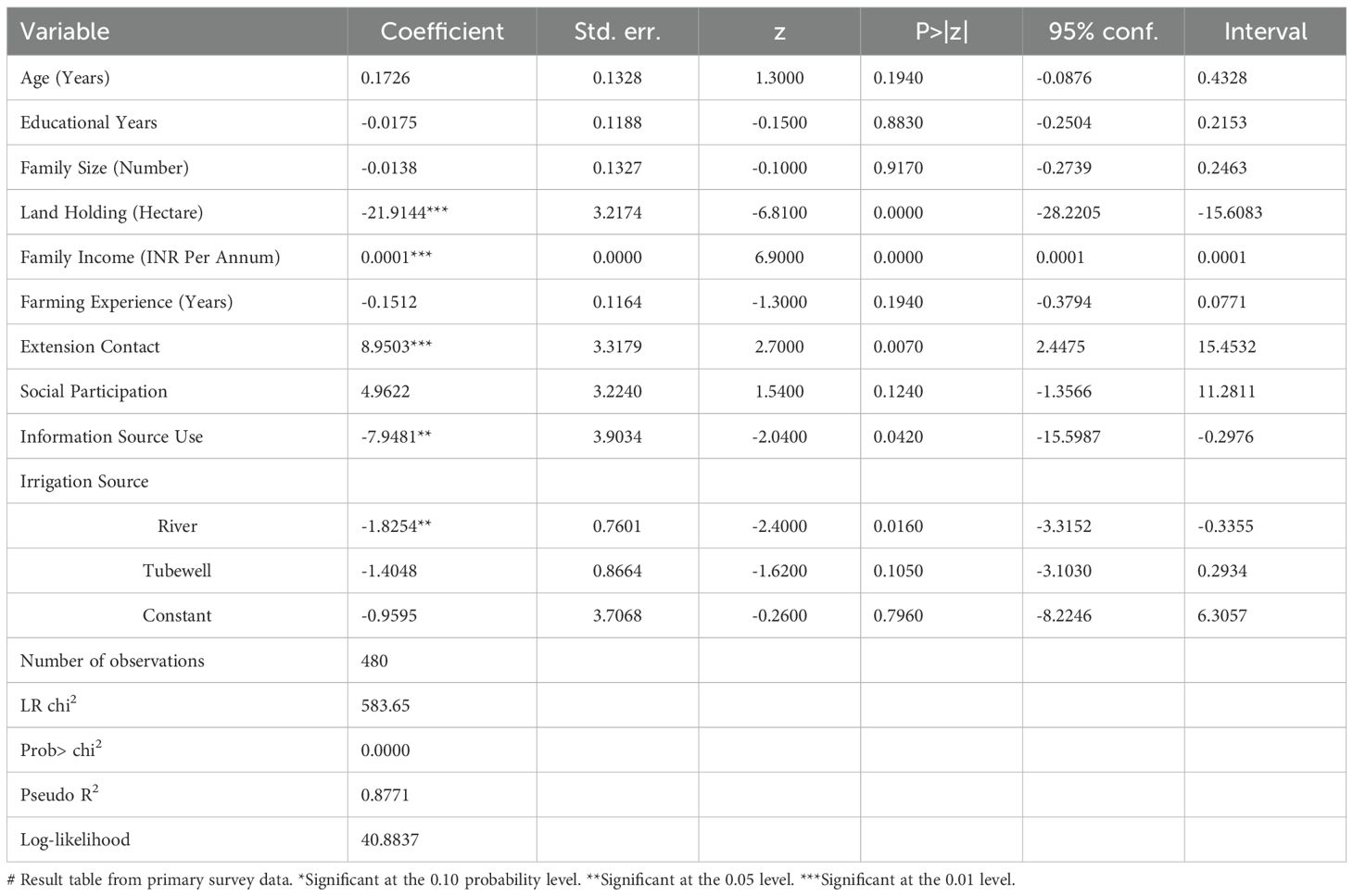
Table 3. Association of socio-economic factors on adoption of raised bed with drip irrigation (RBWD) for onion production.
Farmers who own dug wells tend to adopt drip irrigation more frequently compared to those relying on tubewells, rivers or canals (-1.83, P<0.05). The abundance of water in rivers and canals often leads to less motivation for adopting water-saving measures among farmers using these sources. In contrast, farmers using dug wells as their irrigation source must carefully manage limited water resources, particularly during the post-monsoon season, which prompts their adoption of water-efficient technologies to optimize water usage. Water quality also plays a significant role in RBWD adoption, with water from rivers and canals being more turbid than water from dug wells. Thus, filtration efforts are necessary before using this water in micro-irrigation systems to prevent clogging and internal damage. The limited water availability in dug wells may modestly impact the adoption of drip irrigation for efficient use. Adoption of sustainable agricultural technologies, specifically irrigation technology, is influenced by various factors, including, technical support availability to the farmers, as the latter predominantly benefit by direct access to technical guidance and assistance. Moreover, technological, social, and institutional environments along with economic considerations affecting affordability and cost-effectiveness are crucial contextual factors that influence adoption decisions. The learning willpower of farmers shapes the continuous learning and adaptation capacity, contributing to sustained adoption (Chinseu et al., 2019; Wilson et al., 2001). Furthermore, technology traits, adaptation to local conditions, and the suitability of the technology delivery system play important roles in modulating long-term adoption (Jogo et al., 2021).
3.3 Impact of RBWD irrigation method on yield, quality of produce and water consumption over FBWF
3.3.1 Yield
Farmers who adopted the RBWD technique experienced a significant increase in onion productivity compared to their non-adopting counterparts across all surveyed blocks (Table 4). On average, during the post-monsoon season, adopters experienced an additional yield advantage of 7.06 t ha-1, representing a 23.61% increase in yield. Notably, the most pronounced difference in yield advantage was observed in Shrigonda taluka, where RBWD facilitated a yield of 39.33 t ha-1 (28.90% higher yield), compared to the conventional FBWF method (30.49 t ha-1). The substantial yield increase (13.70%) during the late monsoon season highlights the efficacy of the RBWD system. Though both the seasons studied are completely different with weather conditions, the inter-seasonal difference of 2.19 t ha-1 by RBWD in favor of post-monsoon season is more important as it faces high water shortage compared to late monsoon season.
In onion cultivation, the RBWD method effectively optimized soil moisture conditions, creating favorable growing conditions. RBWD facilitates the drainage of excess water and maintains the required moisture realm in the root zone. Unlike conventional surface irrigation methods, which can lead to soil compaction and sometimes an anaerobic condition in prolonged water retention, RBWD mitigated soil compaction and ensured optimal soil aeration. This fostered a microclimate conducive to robust onion growth. Furthermore, reduced moisture stress under RBWD promoted onion development and minimized losses of valuable fertilizers through volatilization and leaching, thereby enhancing nutrient use efficiency. Research studies have shown that RBWD can lead to a 24.5% yield increase compared to traditional surface irrigation methods (Thangasamy and Singh, 2022).
3.3.2 Produce quality
In addition to increased yield, the adoption of RBWD technology led to the production of high-quality bulbs (Table 5). Across both seasons, the proportion of marketable bulbs in the total harvest was 4.23% to 5.05% higher for farmers who adopted drip irrigation compared to non-adopters. Furthermore, the technology provided an advantage in terms of having a higher proportion of A and B-grade bulbs (bulb diameter of >35 mm) and uniformity in bulb size. Despite higher disease incidence and bolting events during the late monsoon season, a comparatively better volume of high-quality marketable bulbs (92.20%) was recorded. In the post-monsoon season, the marketable onion portion was 94.02%, which is consistent with the earlier study where drip irrigation yielded 83.02% marketable onions compared to 77.6% in surface-irrigated ones (Thangasamy and Singh, 2022). Bhasker et al. (2018) also reported that drip irrigation increased marketable yield by 22.61% in the Rabi season and 18.30% in the Kharif season compared to surface irrigation. Additionally, previous studies (Enciso et al., 2015; Abdelkhalik et al., 2019) also suggested that more frequent irrigations, as possible with a drip system, lead to higher marketable yield.
3.3.3 Water consumption and saving
Several factors influence water use efficiency, including terrain conditions, soil characteristics related to moisture retention, and conveyance factors. In this study, the conveyed water per hour and the duration of irrigation received were measured to calculate water usage (irrigation water). Notably, water consumption by onion crops under the RBWD method was significantly lower compared to the FBWF method (Table 6). Specifically, RBWD resulted in an average water use of 60.91 ha-cm (hectare-centimeters) compared to 85.54 ha-cm by FBWF. In the late monsoon season, RBWD used 55.64 ha-cm, while FBWF used 75.64 ha-cm. Overall, RBWD led to water savings of 28.79% during the post-monsoon season and 24.52% during the late monsoon season across all surveyed talukas. On average, approximately 24.63 ha-cm of water was saved per hectare in the post-monsoon season and 18.55 ha-cm in the late monsoon season with the RBWD method. Variations in water consumption per hectare were observed among the surveyed talukas, likely influenced by differences in soil types, moisture-holding capacities, and irrigation practices (Hatfield and Dold 2019). Supporting these findings, Sankar et al. (2015) reported that under best management practices, drip irrigation in onion achieved a 37.5% saving in irrigation water compared to surface irrigation in Maharashtra. Bhasker et al. (2018) similarly reported that drip systems saved 29.36% of water in Rabi and 27.12% in Kharif season onion production in Nashik, Maharashtra.
In the studied river basin, access to irrigation sources varied among different blocks, with Shrigonda and Parner facing comparatively less access than Junnar and Shirur. The survey highlighted the potential of the RBWD method as a means to enhance irrigation reach in these regions. Notably, RBWD has led to significant water conservation during the post-monsoon season. In both Parner and Shrigonda blocks, water savings were quantified at 30.61% and 30.99%, respectively, highlighting the importance of these enhancements from sustainable water management. Despite variations among blocks and seasons, the present findings emphasize that drip technology significantly conserved water in onion crop cultivation. A few references exist for similar studies in onion crops that investigate water usage at the farmer level. Previous field study by Thangasamy and Singh (2022) has shown comparable results. These insights highlight the importance of adopting efficient irrigation methods like RBWD to address water scarcity challenges in onion cultivation (Kebebe, 2019; Enciso et al., 2015).
3.3.4 Irrigation water productivity
Evaluating water consumption per unit of area serves as a useful indicator for assessing water use efficiency. The water consumed to produce each ton of onions serves as a more appropriate metric to evaluate the efficiency of water consumption and understand the significance of RBWD in improving water use efficiency. Water productivity was determined by dividing the per-hectare yield of onions by the irrigation water consumed per hectare. Notably in the results, it was found that the irrigation water productivity (IWP) of onion was substantially higher for RBWD compared to flood-irrigated (FBWF) conditions (Table 7). Specifically, onions cultivated under RBWD in the post-monsoon season produced 6.23 kg of bulbs per cubic meter of water, whereas flood-irrigated conditions yielded only 3.50 kg. In other words, the same amount of water used under drip conditions resulted in an additional 2.73 kg of yield compared to FBWF. This pattern holds true across both seasons. Importantly, the present findings highlighted that RBWD not only enhanced the quality of produce but also significantly reduced the water required to produce each ton of onions compared to FBWF.
A drip system, by enabling irrigation at the root zone and frequent applications, is often considered an effective method for water conservation and improving the IWP of onions (Lv et al., 2019; Ramalan et al., 2010; Semida et al., 2020; Ibrahim et al., 2022; Weersink and Fulton, 2020; Wu et al., 2023). The IWP in the study, ranged between 5.94 and 6.88 kg m-³, which is considerably lower than the values reported by Ramalan et al. (2010) in Ethiopia (9.16–15.94 kg m-³) and at par with the values reported by Igbadun et al. (2012) in Nigeria (3.8–5.2 kg m-³). Similarly, the present findings indicated that the water productivity of onion crops is comparably higher than that reported by Nyathi et al. for traditional vegetables (1.29 kg m-³) (Nyathi et al., 2019).
Irrigation water productivity (IWP) variations across blocks are influenced by terrain conditions and crop varieties (Terán-Chaves et al., 2023). Water stress hinders plant growth and development (Alghory and Yazar, 2019), reducing water absorption and nutrient uptake (Semida et al., 2020; Muhammad et al., 2024; Sardar et al., 2025). The RBWD technology effectively addressed these challenges (Figure 4).

Figure 4. The comparative water use, onion productivity and water productivity by RBWD and FBWF method. (A) -Flat bed with flood method of irrigation (FBWF) (B) - Raised bed with drip irrigation (RBWD).
3.3.5 Economic analysis of RBWD vis-à-vis FBWF
The adoption of RBWD technology in onion cultivation has provided significant economic benefits compared to the traditional Flat Bed with Flood Irrigation (Table 8). Although the per-hectare costs for RBWD were marginally higher by 5.28% in post-monsoon and 1.83% in late monsoon with consideration of the subsidized cost of establishment for drip irrigation technology per hectare and its cost of depreciation over five years, the enhanced yield under RBWD significantly lowered the cost per ton of onion production. Notably, RBWD results in substantial cost savings per ton of production due to its higher yields and more efficient input use. During the post-monsoon season, RBWD adopters experienced a 23.4% cost reduction, saving ₹2,104.93 ($23.88) per ton compared to FBWF and a similar trend was observed in the late monsoon season, with a cost saving of 16.53%, or ₹1,262.44 ($14.32) per ton. The improved economic performance of RBWD in both the post-monsoon and late monsoon seasons emphasizes its advantages over traditional irrigation methods.
The substantial upfront investment required for drip irrigation infrastructure in the RBWD system is mitigated by long-term cost savings and significant yield enhancements. The multi-seasonal lifespan of the drip system, which can extend up to 5 to 7 years, amplifies its cost-effectiveness, offering sustained economic benefits across several cropping cycles. Similar findings, such as those reported by Neill and Lee (2001), corroborate the economic gains associated with drip irrigation systems, particularly through improved water-use efficiency and input optimization. The technical efficiency of RBWD lies in its ability to optimize resource allocation, enabling farmers to approach the potential production frontier with greater precision and efficiency, as noted by Kale et al (2024). Its primary value is in reducing labor intensity for irrigation, harvesting, and crop management tasks. This aligns with previous research by Hla and Thomas [12], which highlights the comprehensive labor-saving benefits of drip-enabled systems across multiple operational aspects. Consequently, the integration of RBWD positions onion cultivation on a more sustainable and economically viable path, in line with global trends promoting resource-efficient and climate-resilient agricultural practices.
3.4 Positive factors for adoption of RBWD
In the current survey, the fundamental positive factors influencing the adoption of drip irrigation methods were examined. The primary driving force behind the adoption of RBWD was its substantial productivity benefits (scored at 0.94), closely followed by the advantages of water savings (scored at 0.94; Figure 5). It is evident that the likelihood of technology adoption diminishes unless farmers perceive tangible advantages or anticipate enhanced utility from its integration (Bonabana-Wabbi, 2002). When there is no significant difference in outcomes between the two options, and the returns from alternative and conventional practices are similar, it becomes less likely that especially small-scale farmers adopt the new practice (Abara and Singh, 1993). The positive factor of water savings is particularly important because farmers must recognize the existence of a compelling water-related issue that demands an alternative solution. Thus, the adoption of RBWD proves the importance given to water-related challenges by farmers in the Ghod River basin.
The adoption of RBWD was driven by several factors, including its versatility for multiple crops (scored at 0.93) and the labor-saving aspect (scored at 0.93), educational status, extension contact, social participation of the grower along with use of information sources (Kebebe, 2019). This labor saving becomes crucially important when the farmers in the basin are facing labor shortages as the availability of alternate non-farm employment in nearer industrial and urban vicinities. Additionally, as the water permits, farmers in the area often cultivate short-seasonal vegetables and fruits like cucumbers and watermelons. In this short period, RBWD saves the additional tillage and bed preparation operations. Farmers use the RBWD beds after harvesting onions, which saves machine and human labor involvement. Interestingly, two unexpected considerations emerged from this survey regarding the adoption of drip irrigation. First, the need for protection from wild animal attacks (scored at 0.92). In the surveyed blocks, where sugarcane is the dominant cropping system, the presence of leopards posed a significant concern for farmers. Implementing drip irrigation helped minimize human exposure in the fields, providing a safety measure against such risks. Second, dealing with frequent electricity cut-offs during daytime operations (scored at 0.91) influenced the adoption of RBWD. The interrupted power supply forced farmers to irrigate their crops at night, and the drip irrigation system, where, automated techniques such as programmed scheduling, auto on-off functionality, and remote operation, proved highly beneficial in this scenario and further encouraged farmers to adopt RBWD technology.
3.5 Constraints faced by farmers to adopt RBWD
The study also focused on the challenges encountered by farmers while adopting drip irrigation systems. These constraints shed light on the critical factors influencing farmers’ decisions not to adopt this technology. Farmers’ adoption choices are influenced by investment considerations (Caswell et al., 2001). Capital-intensive technologies are more accessible to wealthier farmers, limiting adoption among those with fewer resources (El-Osta and Morehart, 1999; Khanna, 2001). Higher initial investment or the cost of setting up drip irrigation systems is a significant barrier (rated at 0.92). This financial constraint affects adoption decisions, especially for farmers with limited resources. Insufficient credit availability (rated at 0.72) and lack of comprehensive operational knowledge about drip irrigation techniques (rated at 0.90) pose additional obstacles. Policy innovations can play important role to address this constraint. Successful models such as the Andhra Pradesh Micro Irrigation Project (APMIP) and Gujarat Green Revolution Company (GGRC) have streamlined subsidy disbursement, reduced bureaucratic hurdles, and provided technical support, thereby improving adoption rates. In contrast, poorly designed subsidy systems can inflate costs due to bureaucratic delays. Thus, to address these adoption barriers, requires a dual strategy: (i) improving farmers’ access to affordable credit and flexible subsidy mechanisms, such as direct benefit transfers and (ii) strengthening extension services through hands-on training, demonstrations, and farmer-to-farmer learning. Emphasizing the profitability and rapid payback period of drip systems can further encourage uptake (Figure 6).
The constraint of fragmentation of land (0.85) primarily affected those who owned land scattered across different locations. Fragmentation was seen to complicate the implementation and management of drip irrigation systems and mechanized practices like constructing raised beds, thereby consuming more time and resources for these farmers. The logistical hurdles and additional efforts required for such fragmented setups hindered the broader adoption of RBWD among this group of farmers. Interestingly, the lack of nearby dealers did not pose a significant issue for most farmers (Zeng et al., 2018).
4 Conclusion
This study highlighted the crucial role of water-efficient technologies like raised bed with drip irrigation (RBWD) in enhancing onion production. RBWD has demonstrated clear advantages over traditional flat bed and flood irrigation, significantly improving water use efficiency, onion yield, quality and profitability. These combined benefits not only improve farmers’ economic returns but also help to promote more sustainable and resource-efficient methods of farming. The technology allowed farmers to produce a higher proportion of marketable bulbs, optimize resource use, and boost overall productivity. By addressing the region’s growing water management challenges due to urbanization and industrial demands, RBWD contributes to sustainable farming practices in water-scarce environments. This research also underscored the need for extension services in promoting RBWD adoption among farmers. Training programs, on-field demonstrations, and outreach efforts are essential in raising awareness and equipping farmers with the knowledge to implement this technology effectively. While high installation costs and small farms have hindered broader adoption, continued investment in capacity-building initiatives and easily accessible financial support can help overcome these barriers. Subsidies, though intended to ease access, bureaucratic delays may hamper the adoption. Field-level observations also reveal strong state-level variation in micro irrigation scheme (MIS) implementation: Andhra Pradesh and Gujarat have been more effective through dedicated agencies and ICT-based monitoring, whereas Punjab and Uttar Pradesh lag despite significant potential.
Policies beyond rigid subsidies toward more flexible models such as direct benefit transfers, accessible credit, will boost the large scale adoption. This study reflects transformative changes brought by a simple technology and also its potential. In the long run, RBWD has the potential to significantly improve onion farming’s resilience and sustainability. Further research may focus on validating these findings across different agro-climatic zones, assessing long-term soil health and resource-use impacts, fertigation through drip and exploring the scalability of RBWD for different crops under diverse farming systems.
Data availability statement
The original contributions presented in the study are included in the article/Supplementary Material. Further inquiries can be directed to the corresponding author.
Ethics statement
Ethical approval was not required for the study involving humans in accordance with the local legislation and institutional requirements. Written informed consent to participate in this study was not required from the participants or the participants’ legal guardians/next of kin in accordance with the national legislation and the institutional requirements.
Author contributions
RK: Resources, Funding acquisition, Writing – review & editing, Writing – original draft, Validation, Supervision, Methodology, Project administration, Conceptualization. AG: Writing – original draft, Software, Formal analysis, Visualization, Investigation. SSG: Project administration, Supervision, Writing – review & editing, Resources. AT: Project administration, Supervision, Methodology, Writing – original draft. SW: Visualization, Formal analysis, Software, Writing – original draft. SYG: Writing – original draft, Investigation, Formal analysis, Methodology. SS: Visualization, Writing – original draft, Investigation. SM: Writing – review & editing, Data curation, Writing – original draft, Formal analysis. VT: Writing – review & editing, Formal analysis, Software, Visualization. KK: Formal analysis, Methodology, Writing – review & editing. VM: Resources, Funding acquisition, Writing – review & editing.
Funding
The author(s) declare financial support was received for the research and/or publication of this article. The present study was funded by the Development Support Centre under ITC Mission Sunhera Kal, Narayangaon, Pune. The APC for the publication of this article was funded by ICAR-DOGR, Pune.
Conflict of interest
The authors declare that the research was conducted in the absence of any commercial or financial relationships that could be construed as a potential conflict of interest.
Generative AI statement
The author(s) declare that no Generative AI was used in the creation of this manuscript.
Any alternative text (alt text) provided alongside figures in this article has been generated by Frontiers with the support of artificial intelligence and reasonable efforts have been made to ensure accuracy, including review by the authors wherever possible. If you identify any issues, please contact us.
Publisher’s note
All claims expressed in this article are solely those of the authors and do not necessarily represent those of their affiliated organizations, or those of the publisher, the editors and the reviewers. Any product that may be evaluated in this article, or claim that may be made by its manufacturer, is not guaranteed or endorsed by the publisher.
Supplementary material
The Supplementary Material for this article can be found online at: https://www.frontiersin.org/articles/10.3389/fagro.2025.1634867/full#supplementary-material
References
Abara I. O. C. and Singh S. (1993). Ethics and biases in technology adoption: The small farm argument. Technol. Forecasting Soc. Change 43, 280–300. doi: 10.1016/0040-1625(93)90057-E
Abdelkhalik A., Pascual B., Nájera I., Baixauli C., and Pascual-Seva N. (2019). Regulated Deficit Irrigation as a Water-Saving Strategy for Onion Cultivation in Mediterranean Conditions. Agronomy 9, 521. doi: 10.3390/agronomy9090521
Abou Fayssal S., Kumar P., Popescu S. M., Sardar H., Ahmad R., Gupta D., et al. (2024). Health risk assessment of heavy metals in saffron (Crocus sativus L.) cultivated in domestic wastewater and lake water irrigated soils. Heliyon 10:e27138 doi: 10.1016/j.heliyon.2024.e27138
Alghory A. and Yazar A. (2019). Evaluation of crop water stress index and leaf water potential for deficit irrigation management of sprinkler-irrigated wheat. Irrig Sci. 37, 61–77. doi: 10.1007/s00271-018-0603-y
Bhasker P., Singh R. K., Gupta R. C., Sharma H. P., and Gupta. P. K. (2018). Effect of drip irrigation on growth and yield of onion (Allium cepa L.). J. Spices Aromatic Crops 27, 32–37. doi: 10.25081/josac.2018.v27.i1.1012
Binoy K., Yadav A. K., and Vardhan V. V. (2023). Multi-stakeholder approach to implementing water stewardship: The case of the Ghod River basin. Irrigation Drainage 72, 1298–1305. doi: 10.1002/ird.2836
Bonabana-Wabbi J. (2002). Assessing Factors Affecting Adoption of Agricultural Technologies: The Case of Integrated Pest Management (IPM) in Kumi District, Eastern Uganda (Blacksburg, Virginia: Virginia Polytechnic Institute and State University).
Bravo-Ureta B. E. and Evenson R. E. (1994). Efficiency in agricultural production: The case of peasant farmers in eastern Paraguay. Agric. Econ 10, 27–37. doi: 10.1016/0169-5150(94)90037-X
Caswell M., Fugile K., Ingram C., Jans S., and Kascak C. (2001). Adoption of Agricultural Production Practices: Lessons Learned from the U.S. Department of Agriculture Area Studies Project (No. 792) (Resource Economics Division, Economic Research Service, U.S. Department of Agriculture).
Chand S., Kishore P., Kumar S., and Srivastava S. K. (2020). Potential, Adoption and Impact of Micro Irrigation in India Agriculture. Policy Paper 36, ICAR-National Institute of Agricultural Economics and Policy Research (NIAP), New Delhi.
Chinseu E., Dougill A., and Stringer L. (2019). Why do smallholder farmers dis-adopt conservation agriculture? Insights Malawi. Land Degrad Dev. 30, 533–543. doi: 10.1002/ldr.3190
El-Osta H. S. and Morehart M. J. (1999). Technology Adoption Decisions in Dairy Production and the Role of Herd Expansion. Agric. Resour. Econ. Rev. 28, 84–95. doi: 10.1017/S1068280500001003
Enciso J., Jifon J., Anciso J., and Ribera L. (2015). Productivity of Onions Using Subsurface Drip Irrigation versus Furrow Irrigation Systems with an Internet Based Irrigation Scheduling Program. Int. J. Agron. 2015, e178180. doi: 10.1155/2015/178180
FAOSTAT. (2024). Available online at: https://data.apps.fao.org/catalog/dataset/crop-production-yield-harvested-area-global-national-annual-faostat (Accessed June 10, 2024).
Gadge S. S., Kale R. B., Gupta A. J., Thangasamy A., Mahajan V., and Singh M. (2022). “Impact of improved onion and garlic technologies at farmers’ field,” in Good Agricultural Practices in Onion and Garlic Production (ICAR- Directorate of Onion and Garlic Research, Pune, Maharashtra and National Institute of Agricultural Extension Management, Hyderabad, Telangana).
Garg K. K., Bharati L., Gaur A., George B., Acharya S., Jella K., et al. (2012). Spatial mapping of agricultural water productivity using the swat model in upper Bhima catchment, India. Irrigation Drainage 61, 60–79. doi: 10.1002/ird.618
Gedam P. A., Thangasamy A., Shirsat D. V., Ghosh S., Bhagat K. P., Sogam O. A., et al. (2021). Screening of Onion (Allium cepa L.) Genotypes for Drought Tolerance Using Physiological and Yield Based Indices Through Multivariate Analysis. Front. Plant Sci. 12. doi: 10.3389/fpls.2021.600371
Gethe R. M., Pawar V. S., Sonawane D. A., and Kadlag A. D. (2006). Influence of planting, layouts, irrigation regimes and fertilizer levels on growth and yield of onion under microsprinkler. J. Maharashtra Agric. Univ. 31, 272–274.
Gorantiwar S. D., Papattiwar P. S., Legad S. M., and Borude D. M. (1991). Evaluation of sprinkler and border methods of irrigation for onion. Maharastra J. Agriuculture 5, 88–92.
Guo J., Zheng L., Ma J., Li X., and Chen R. (2023). Meta-Analysis of the Effect of Subsurface Irrigation on Crop Yield and Water Productivity. Sustainability 15, 15716. doi: 10.3390/su152215716
Hatfield J. L. and Dold C. (2019). Water-Use Efficiency: Advances and Challenges in a Changing Climate. Front. Plant Sci. 10. doi: 10.3389/fpls.2019.00103
Ibrahim H. H., Abdalla A. A., and Salem W. S. (2022). Efficacy of irrigation intervals and chemical weed control on optimizing bulb yield and quality of onion (Allium cepa L.). Bragantia 81, e1722. doi: 10.1590/1678-4499.20210137
Igbadun H. E., Ramalan A. A., and Oiganji E. (2012). Effects of regulated deficit irrigation and mulch on yield, water use and crop water productivity of onion in Samaru, Nigeria. Agric. Water Manage. 109, 162–169. doi: 10.1016/j.agwat.2012.03.006
Iráizoz B., Rapún M., and Zabaleta I. (2003). Assessing the technical efficiency of horticultural production in Navarra, Spain. Agric. Syst. 78, 387–403. doi: 10.1016/S0308-521X(03)00039-8
Jogo W., Bocher T., and Grant F. (2021). Factors influencing farmers’ dis-adoption and retention decisions for biofortified crops: the case of orange-fleshed sweetpotato in Mozambique. Agrekon 60, 445–459. doi: 10.1080/03031853.2021.1956555
Kale R. B., Gavhane A. D., Thorat V. S., Gadge S. S., Wayal S. M., Gaikwad S. Y., et al. (2024). Efficiency dynamics among onion growers in Maharashtra: a comparative analysis of drip irrigation adopters and non-adopters. BMC Plant Biol. 24, 237. doi: 10.1186/s12870-024-04875-2
Kebebe E. (2019). Bridging technology adoption gaps in livestock sector in Ethiopia: A innovation system perspective. Technol. Soc. 57, 30–37. doi: 10.1016/j.techsoc.2018.12.002
Khandagale K., Roylawar P., Kulkarni O., Khambalkar P., Ade A., Kulkarni A., et al. (2022). Comparative transcriptome analysis of onion in response to infection by Alternaria porri (Ellis) cifferi. Front. Plant Sci. 13, 857306. doi: 10.3389/fpls.2022.857306
Khanna M. (2001). Sequential Adoption of Site-Specific Technologies and its Implications for Nitrogen Productivity: A Double Selectivity Model. Am. J. Agri Econ 83, 35–51. doi: 10.1111/0002-9092.00135
Li X., Zhang X., Niu J., Tong L., Kang S., Du T., et al. (2016). Irrigation water productivity is more influenced by agronomic practice factors than by climatic factors in Hexi Corridor, Northwest China. Sci. Rep. 6, 37971. doi: 10.1038/srep37971
Lv H., Lin S., Wang Y., Lian X., Zhao Y., Li Y., et al. (2019). Drip fertigation significantly reduces nitrogen leaching in solar greenhouse vegetab le production system. Environ. pollut. 245, 694–701. doi: 10.1016/j.envpol.2018.11.042
Muhammad H. M. D., Naz S., Ahmad R., Ali E., Anwar M., Altaf M. A., et al. (2024). Melatonin triggers salinity tolerance in pansy (Viola tricolor) by regulation of defense system. J. King Saud University-Science 36, 103286. doi: 10.1016/j.jksus.2024.103286
Narayanamoorthy A. (2016). “Water Saving Technology in India: Adoption and Impacts,” in Indian Water Policy at the Crossroads: Resources, Technology and Reforms. Eds. Narain V. and Narayanamoorthy ,.A. (Springer International Publishing, Cham), 209–231. doi: 10.1007/978-3-319-25184-4_11
Neill S. P. and Lee D. R. (2001). Explaining the Adoption and Disadoption of Sustainable Agriculture: The Case of Cover Crops in Northern Honduras. Economic Dev. Cultural Change 49, 793–820. doi: 10.1086/452525
Nyathi M. K., Mabhaudhi T., Van Halsema G. E., Annandale J. G., and Struik P. C. (2019). Benchmarking nutritional water productivity of twenty vegetab les - A review. Agric. Water Manage. 221, 248–259. doi: 10.1016/j.agwat.2019.05.008
Patel A., Kushwaha N. L., Rajput J., and Gautam P. V. (2023). “Advances in micro-irrigation practices for improving water use efficiency in dryland agriculture,” in Enhancing resilience of dryland agriculture under changing climate: Interdisciplinary and convergence approaches (Springer Nature Singapore, Singapore), 157–176.
Piri H. and Naserin A. (2020). Effect of different levels of water, applied nitrogen and irrigation methods on yield, yield components and IWUE of onion. Scientia Hortic. 268, 109361. doi: 10.1016/j.scienta.2020.109361
Putra M. P. I. F., Pradhan P., and Kropp J. P. (2020). A systematic analysis of Water-Energy-Food security nexus: A South Asian case study. Sci. Total Environ. 728, 138451. doi: 10.1016/j.scitotenv.2020.138451
Ramalan A. A., Nega H., and Oyebode M. A. (2010). “Effect of deficit irrigation and mulch on water use and yield of drip irrigated onions,” in Presented at the SUSTAINABLE IRRIGATION 2010(Bucharest, Romania: WIT Press), 134, 39–50. doi: 10.2495/SI100041
Sankar V., Thangasamy A., and Lawande K. E. (2015). Effect of Drip Irrigation on Onion (Allium сеpa) Seed Production under Western Maharashtra Conditions. Int. J. Of Trop. Agric. 33, 621–625.
Sansan O. C., Ezin V., Ayenan M. A. T., Chabi I. B., Adoukonou-Sagbadja H., Saïdou A., et al. (2024). Onion (Allium cepa L.) and drought: current situation and perspectives. Scientifica 2024, p.6853932. doi: 10.1155/2024/6853932
Sardar H., Waqas M., Nawaz A., Naz S., Ali S., Ejaz S., et al. (2025). Amendment of Tomato (Lycopersicon esculentum L.) Grown in Calcareous Soil with Spent Mushroom Substrate-derived Biochar: Improvement of Morphological, Biochemical, Qualitative Attributes, and Antioxidant Activities. J. Soil Sci. Plant Nutr., 1–17. doi: 10.1007/s42729-025-02265-7
Saudy H. S. and El–Metwally I. M. (2019). Nutrient Utilization Indices of NPK and Drought Management in Groundnut under Sandy Soil Conditions. Commun. Soil Sci. Plant Anal. 50, 1821–1828. doi: 10.1080/00103624.2019.1635147
Semida W. M., Abdelkhalik A., Rady M. O. A., Marey R. A., and Abd El-Mageed T. A. (2020). Exogenously applied proline enhances growth and productivity of drought stressed onion by improving photosynthetic efficiency, water use efficiency and up-regulating osmoprotectants. Scientia Hortic. 272, 109580. doi: 10.1016/j.scienta.2020.109580
Serote B., Mokgehle S., Senyolo G., du Plooy C., Hlophe-Ginindza S., Mpandeli S., et al. (2023). Exploring the barriers to the adoption of climate-smart irrigation technologies for sustainable crop productivity by smallholder farmers: Evidence from South Africa. Agriculture 13, 246. doi: 10.3390/agriculture13020246
Sharma B., Sikka A., Lautze J., Mabhaudhi T., and Mabhaudhi T. (2025). “Management and Agricultural Water Productivity Improvement in India and The Ganges Basin,” in Enhancing Water and Food Security Through Improved Agricultural Water Productivity. Eds. Chimonyo V. G. P., Senzanje A., and Chivenge P. P. (Springer, Singapore). doi: 10.1007/978-981-96-1848-4_3
Singh J., Alhag S. K., Al-Shahari E. A., Al-Shuraym L. A., Alsudays I. M., Ahmed M. T., et al. (2024). An experimental and prediction modeling study on water lettuce (Pistia stratiotes L.) assisted heavy metals removal from glass industry effluent. Environ. Sci. pollut. Res. 31, 28090–28104. doi: 10.1007/s11356-024-32664-9
Terán-Chaves C. A., Montejo-Nuñez L., Cordero-Cordero C., and Polo-Murcia S. M. (2023). Water Productivity Indices of Onion (Allium cepa l.) under Drip Irrigation and Mulching in a Semi-Arid Tropical Region of Colombia. Horticulturae 9, 632. doi: 10.3390/horticulturae9060632
Thangasamy A. and Singh M. (2022). “Good agricultural practices of nutrient and water management in onion and garlic,” in Good Agricultural Practices in Onion and Garlic Production. MANAGE, Hyderabad
Udmale P. D., Ichikawa Y., S. Kiem A., and N. Panda S. (2014). Drought Impacts and Adaptation Strategies for Agriculture and Rural Livelihood in the Maharashtra State of India. TOASJ 8, 41–47. doi: 10.2174/1874331501408010041
Weersink A. and Fulton M. (2020). Limits to Profit Maximization as a Guide to Behavior Change. Appl. Eco Perspect. Pol. 42, 67–79. doi: 10.1002/aepp.13004
Wilson P., Hadley D., and Asby C. (2001). The influence of management characteristics on the technical efficiency of wheat farmers in eastern England. Agric. Econ 24, 329–338. doi: 10.1111/j.1574-0862.2001.tb00034.x
Wu Y., Si W., Yan S., Wu L., Zhao W., Zhang J., et al. (2023). Water consumption, soil nitrate-nitrogen residue and fruit yield of drip-irrigated greenhouse tomato under various irrigation levels and fertilization practices. Agric. Water Manage. 277, 108092. doi: 10.1016/j.agwat.2022.108092
Yang P., Wu L., Cheng M., Fan J., Li S., Wang H., et al. (2023a). Review on Drip Irrigation: Impact on Crop Yield, Quality, and Water Productivity in China. Water 15, 1733. doi: 10.3390/w15091733
Yang P., Wu L., Cheng M., Fan J., Li S., Wang H., et al. (2023b). Review on drip irrigation: impact on crop yield, quality, and water productivity in China. Water 15, 1733. doi: 10.3390/w15091733
Keywords: onion, raised bed, water productivity, adoption drivers, post-adoption constraints, drip irrigation
Citation: Kale RB, Gavhane AD, Gadge SS, Thangasamy A, Wayal SM, Gaikwad SY, Singh S, More SJ, Thorat VS, Khandagale K and Mahajan V (2025) Potential of improved irrigation technologies for onion farming in Maharashtra, India: a study of productivity and adoption drivers. Front. Agron. 7:1634867. doi: 10.3389/fagro.2025.1634867
Received: 25 May 2025; Accepted: 15 October 2025;
Published: 31 October 2025.
Edited by:
Hanmi Zhou, Henan University of Science and Technology, ChinaReviewed by:
Sami Abou Fayssal, University of Forestry, BulgariaYohannes Ketsela, Arba Minch University, Ethiopia
Copyright © 2025 Kale, Gavhane, Gadge, Thangasamy, Wayal, Gaikwad, Singh, More, Thorat, Khandagale and Mahajan. This is an open-access article distributed under the terms of the Creative Commons Attribution License (CC BY). The use, distribution or reproduction in other forums is permitted, provided the original author(s) and the copyright owner(s) are credited and that the original publication in this journal is cited, in accordance with accepted academic practice. No use, distribution or reproduction is permitted which does not comply with these terms.
*Correspondence: Rajiv B. Kale, cmtyYWppdm5kcmlAZ21haWwuY29t
 Rajiv B. Kale
Rajiv B. Kale Abhishek D. Gavhane
Abhishek D. Gavhane S. S. Gadge1
S. S. Gadge1 Sagar M. Wayal
Sagar M. Wayal Shivam Y. Gaikwad
Shivam Y. Gaikwad Sanket J. More
Sanket J. More Kiran Khandagale
Kiran Khandagale